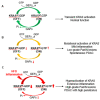Pancreatic Tumorigenesis: Oncogenic KRAS and the Vulnerability of the Pancreas to Obesity
- PMID: 33668583
- PMCID: PMC7918840
- DOI: 10.3390/cancers13040778
Pancreatic Tumorigenesis: Oncogenic KRAS and the Vulnerability of the Pancreas to Obesity
Abstract
Pancreatic ductal adenocarcinoma (PDAC) is one of the most lethal malignancies and KRAS (Kirsten rat sarcoma 2 viral oncogene homolog) mutations have been considered a critical driver of PDAC initiation and progression. However, the effects of mutant KRAS alone do not recapitulate the full spectrum of pancreatic pathologies associated with PDAC development in adults. Historically, mutant KRAS was regarded as constitutively active; however, recent studies have shown that endogenous levels of mutant KRAS are not constitutively fully active and its activity is still subject to up-regulation by upstream stimuli. Obesity is a metabolic disease that induces a chronic, low-grade inflammation called meta-inflammation and has long been recognized clinically as a major modifiable risk factor for pancreatic cancer. It has been shown in different animal models that obesogenic high-fat diet (HFD) and pancreatic inflammation promote the rapid development of mutant KRAS-mediated PDAC with high penetrance. However, it is not clear why the pancreas with endogenous levels of mutant KRAS is vulnerable to chronic HFD and inflammatory challenges. Recently, the discovery of fibroblast growth factor 21 (FGF21) as a novel anti-obesity and anti-inflammatory factor and as a downstream target of mutant KRAS has shed new light on this problem. This review is intended to provide an update on our knowledge of the vulnerability of the pancreas to KRAS-mediated invasive PDAC in the context of challenges engendered by obesity and associated inflammation.
Keywords: FGF21; KRAS; PDAC; inflammation; obesity.
Conflict of interest statement
The authors declare no potential conflict of interest.
Figures


Similar articles
-
Differential Effects of Dietary Macronutrients on the Development of Oncogenic KRAS-Mediated Pancreatic Ductal Adenocarcinoma.Cancers (Basel). 2022 May 31;14(11):2723. doi: 10.3390/cancers14112723. Cancers (Basel). 2022. PMID: 35681705 Free PMC article.
-
Obesogenic high-fat diet heightens aerobic glycolysis through hyperactivation of oncogenic KRAS.Cell Commun Signal. 2019 Feb 28;17(1):19. doi: 10.1186/s12964-019-0333-7. Cell Commun Signal. 2019. PMID: 30819189 Free PMC article.
-
YAP1 and TAZ Control Pancreatic Cancer Initiation in Mice by Direct Up-regulation of JAK-STAT3 Signaling.Gastroenterology. 2016 Sep;151(3):526-39. doi: 10.1053/j.gastro.2016.05.006. Epub 2016 May 20. Gastroenterology. 2016. PMID: 27215660 Free PMC article.
-
Central role of Yes-associated protein and WW-domain-containing transcriptional co-activator with PDZ-binding motif in pancreatic cancer development.World J Gastroenterol. 2019 Apr 21;25(15):1797-1816. doi: 10.3748/wjg.v25.i15.1797. World J Gastroenterol. 2019. PMID: 31057295 Free PMC article. Review.
-
Highlights on the Role of KRAS Mutations in Reshaping the Microenvironment of Pancreatic Adenocarcinoma.Int J Mol Sci. 2021 Sep 23;22(19):10219. doi: 10.3390/ijms221910219. Int J Mol Sci. 2021. PMID: 34638560 Free PMC article. Review.
Cited by
-
The Role of Adipokines in Pancreatic Cancer.Front Oncol. 2022 Jul 8;12:926230. doi: 10.3389/fonc.2022.926230. eCollection 2022. Front Oncol. 2022. PMID: 35875143 Free PMC article. Review.
-
The Intricate Crosstalk Between Insulin and Pancreatic Ductal Adenocarcinoma: A Review From Clinical to Molecular.Front Cell Dev Biol. 2022 Feb 17;10:844028. doi: 10.3389/fcell.2022.844028. eCollection 2022. Front Cell Dev Biol. 2022. PMID: 35252207 Free PMC article. Review.
-
Obesity and Pancreatic Cancer: Insight into Mechanisms.Cancers (Basel). 2021 Oct 10;13(20):5067. doi: 10.3390/cancers13205067. Cancers (Basel). 2021. PMID: 34680216 Free PMC article. Review.
-
Differential Effects of Dietary Macronutrients on the Development of Oncogenic KRAS-Mediated Pancreatic Ductal Adenocarcinoma.Cancers (Basel). 2022 May 31;14(11):2723. doi: 10.3390/cancers14112723. Cancers (Basel). 2022. PMID: 35681705 Free PMC article.
-
Early elevations of RAS protein level and activity are critical for the development of PDAC in the context of inflammation.Cancer Lett. 2024 Apr 1;586:216694. doi: 10.1016/j.canlet.2024.216694. Epub 2024 Feb 1. Cancer Lett. 2024. PMID: 38307409 Free PMC article.
References
Publication types
Grants and funding
LinkOut - more resources
Full Text Sources
Other Literature Sources
Miscellaneous

